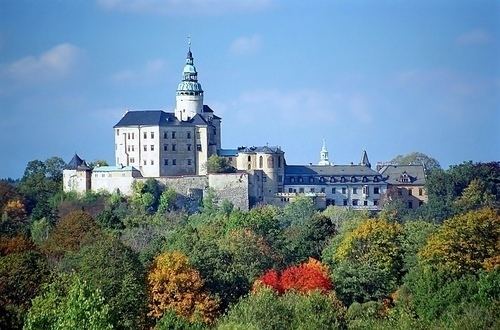- summer (DST) CEST (UTC+2) Area 31.62 km² Founded 13th century | Elevation 295 m Local time Saturday 5:47 AM | |
 | ||
Weather 3°C, Wind SW at 19 km/h, 89% Humidity Points of interest Jizera Mountains, Friedland Castle, Městské muzeum Frýdlant, Křížový vrch, Rozhledna Frydlant | ||
Frýdlant, sometimes cited also as Frýdlant v Čechách ( [ˈfriːdlant ˈf tʃɛxaːx]; German: Friedland in Böhmen) is a town in the Liberec District of the Liberec Region in the Czech Republic.
Contents
- Map of FrC3BDdlant Czechia
- Geography
- Districts
- History
- Castle
- Notable people
- International relations
- References
Map of Fr%C3%BDdlant, Czechia
Geography
The town is located in the north of the historic Bohemia region, close to the border with Poland. It is situated in the northern foothills (Frýdlantská pahorkatina) of the Jizera Mountains, on the Smědá river. The Frýdlant municipality has approximately 7,500 inhabitants.
Districts
Czech names, followed by German equivalents:
History
The area was settled by Slavic (Sorbian) tribes from the 6th century onwards and in the 12th century was incorporated into the Upper Lusatian (Land Budissin) territory, then held by the Margraves of Meissen. It belonged to the Lordship of Seidenberg (Zawidów), which in 1158 passed to the Přemyslid king Vladislaus II of Bohemia.
The town itself was first mentioned in 1278, when the Bieberstein noble family from Meissen was enfeoffed with the estates of Friedland and Seidenberg by King Ottokar II and took their residence at the Gothic Frýdlant Castle. Upon the extinction of the line in 1551, the lordship was purchased by the Silesian noble House of Redern from the hands of Emperor Ferdinand I.
Meanwhile, the Lands of the Bohemian Crown had become a part of the Habsburg Monarchy. Christoph von Redern opposed Emperor Ferdinand II during the Counter-Reformation and after the Defenestration of Prague was among the uprising Bohemian Protestant estates, who were defeated at the 1620 Battle of White Mountain. While his cousin Joachim Andreas von Schlick was arrested and executed, Redern saved his life; however, his lands were seized by the Emperor and given in reward to his General Albrecht von Wallenstein, who titled himself "Duke of Friedland" and took his residence at Jičín. The nominal sovereignty of Friedland-Seidenberg was also revoked at this time.
Until 1918, Friedland in Böhmen was part of the Austrian monarchy (Cisleithanian side after the Compromise of 1867). It was the head of a district with the same name, one of the 94 Bezirkshauptmannschaften in the Bohemian crown land. In 1875, a railway line from Liberec via Frýdlant to Zawidów was put into operation. Lines to Mirsk (Friedberg) and the Frýdlant–Heřmanice Railway to Zittau followed soon. The new town hall was erected in 1893 according to plans by the Viennese architect Franz Neumann.
Following the 1938 Munich Agreement, the town was occupied by Nazi Germany and incorporated as Friedland (Isergebirge), one of the municipalities in the Reichsgau Sudetenland. After World War II, it fell back to the Third Czechoslovak Republic and renamed Frýdlant v Čechách. The German-speaking population was expelled according to the Beneš decrees and replaced by Czech settlers.
Castle
In the 13th century the castle was held by the Ronow noble family (Ronovci). It became the residence of the House of Bieberstein, when in 1278 the Bohemian king Ottokar II ceded the lordship to Rulco of Bieberstein for his support against the Habsburg king Rudolf I of Germany. On 1 April 1554, lordship and castle were purchased by Friedrich von Redern. After his descendants were disseized by Emperor Ferdinand II, his generalissimo Albrecht von Wallenstein ruled as Duke of Friedland until his assassination in 1634. The estates then passed to the Austrian commander Matthias Gallas, whose descendants (Clam-Gallas) held it until 1945.
The nowadays building complex consists of the Gothic castle with a high tower and a Renaissance château. The castle had a museum as early as 1801 and today is one of the most visited in the Czech Republic.
Notable people
International relations
Frýdlant is part of the Friedliches Land (Peaceful Land) municipal association with:
